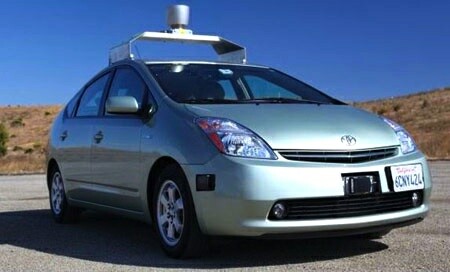''' TEACHING COMPUTERS TO DRIVE '''
ONCE THE SENSORS and activators are in place, building a driverless car is essentially a software problem.
Google's approach involves deriving a route manually, -with all the sensor's switched on, to build a detailed 3D map of features such as signs, guardrails and overpasses, says Anothony Levandowski, project leader for Google's self-driving cars.
Then, when the autonomous mode driving is switched on [accompanied by a spaceship sound-effects], the software can predict hazards with reasonable accuracy.
A shaded bridge in a damp valley, for example, maybe icy until noon if the night time temperature drops below a certain point. Each time a car follows a particular route, it collects more data.
Google's software also ingests data on speed limits and recorded accidents. Because the car's roof-mounted sensors can see in all directions, it arguably has a greater situational awareness than a human driver.
One area where humans are still clearly superior, however, is on judging an object's material or weight . Unable to tell the difference between a chunk of mattress and a block of steel on the carriageway, a self-driving vehicle might-
Brake harder than would be wise, says Sebastian Thrun, a Stanford University roboticist who led the development of Google's driverless cars. Similarly, a carpet of leaves or snow might lead a robotic car to miscalculate of road's edge.
But as driverless cars clock up more miles, solutions are being worked out. To evaluate the dangers posed by an object on the road, Google's software takes into account the behaviour of other vehicles. If other cars do not swerve or brake-
To avoid it, it is more likely to be a plastic bag than a rock. ''Fusing'' data from various types of sensors, can also remove uncertainty. To judge distances, for example, radar or lidar sensors in the front bumpers can be supplemented by video cameras. Infra-red sensors can pick up the heat signature of a human obscured by fog.
It is even possible to make judgements about the mental state of other drivers. Software developed by Probayes a firm based near Grenoble, in France identifies and then steers clear of drivers who are angry, drowsy, tipsy, or aggressive. Upset drivers tend to speed up and brake quickly.
Sleepy drivers tend to drift off course gradually and veer back sharply. Drunk drivers struggle to keep a straight line. The firm sells it software to Toyota, Japan's car giant.
Google's cars have even been programmed to behave appropriately at junction such as four-way stops, edging forward cautiously to signal their intentions and stopping quickly if another driver moves out of turn.
So far Google's vehicles have not been involved in a single accident while under computer control, although a Google car crashed into the back of another car in 2011, it was being driven by a human at the time.
The company says its cars have yet to master snow covered roads, or reading temporary signs and signals around roadworks.
A telling sign of progress, however, is that Google researchers have recently started using the cars solo, rather than in pairs.
This lets individual researchers commute to work in their autonomous cars.
BUT, autonomous vehicles for individuals may still be a few years away, but they are already being used in industry. Just recently, Rio Tinto, an Anglo-Australian mining giant, decided to increase its fleet of self-driving trucks-
Which haul iron-ore, from ten to 150 vehicles within four years.
The Honour and Serving of ''Advance Operational Research'' on Sensors, Software and Robotics continues. Thank you for reading and sharing forward. And See you on the following one.
With respectful dedication to the Students, Professors and Teachers of innovation, Engineering and Advance Sciences. See Ya all on !WOW! -the World Students Society Computers-Internet-Wireless:
''' The World To Come '''
Good Night and God Bless
SAM Daily Times - the Voice of the Voiceless

.png)


0 comments:
Post a Comment
Grace A Comment!